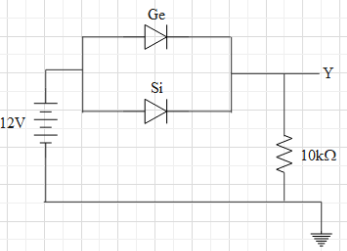
Two junction diodes one of germanium (Ge) and other of silicon (Si) are connected as shown in the figure, to a battery of emf 12V and a load resistance

A. 12V
B. 11V
C. 11.3V
D. 11.7V

Answer
489.9k+ views
Hint: Check whether the diodes are in forward biased or reverse biased condition. Then find the potential difference across the diode. Since the negative terminal of the battery is grounded, it will be at potential of 0V. The current will flow through that diode with less resistance.
Complete answer:
In the figure, we can see that the p (anode terminal) sides of both the diodes are connected to the positive terminal of the battery. And the n sides (cathode terminal) of the both the diodes are connected to the negative side of the battery. This means that the anodes of the diodes are at a higher potential than that of the cathodes, which implies that both the diodes are in forward biased condition. This means both of them will allow current to pass through them.
However, we see that the diodes are in parallel connection, which means that both of them must have equal potential difference across them. We see that both the diodes have different voltages for which they conduct. Now, what will happen is that current will find the easiest path to travel. In other words, it will flow through that diode with less resistance. The diode having lower conducting voltage, will provide less resistance. In this case, the Ge diode has less conducting voltage. Therefore, the current will only pass through the Ge diode and potential difference across the diodes will be 0.3V.
We see in the figure that the negative terminal of the battery is grounded. This means that the negative terminal of the battery is at a potential of 0V. Therefore, the positive terminal of the battery is at a potential of 12V. And we just found that the potential drop of 0.3V across the diodes.Therefore, the potential at Y is
Hence, the correct option is D.
Note: Current always flows from a point of higher potential to a point of lower potential. Therefore, when a diode is forward biased, current flows from its anode to its cathode. When the anode of the diode is at lower potential than that of its cathode, we say that the diode is reverse biased. A diode does not allow any current pass through when reverse biased.
Complete answer:
In the figure, we can see that the p (anode terminal) sides of both the diodes are connected to the positive terminal of the battery. And the n sides (cathode terminal) of the both the diodes are connected to the negative side of the battery. This means that the anodes of the diodes are at a higher potential than that of the cathodes, which implies that both the diodes are in forward biased condition. This means both of them will allow current to pass through them.
However, we see that the diodes are in parallel connection, which means that both of them must have equal potential difference across them. We see that both the diodes have different voltages for which they conduct. Now, what will happen is that current will find the easiest path to travel. In other words, it will flow through that diode with less resistance. The diode having lower conducting voltage, will provide less resistance. In this case, the Ge diode has less conducting voltage. Therefore, the current will only pass through the Ge diode and potential difference across the diodes will be 0.3V.
We see in the figure that the negative terminal of the battery is grounded. This means that the negative terminal of the battery is at a potential of 0V. Therefore, the positive terminal of the battery is at a potential of 12V. And we just found that the potential drop of 0.3V across the diodes.Therefore, the potential at Y is
Hence, the correct option is D.
Note: Current always flows from a point of higher potential to a point of lower potential. Therefore, when a diode is forward biased, current flows from its anode to its cathode. When the anode of the diode is at lower potential than that of its cathode, we say that the diode is reverse biased. A diode does not allow any current pass through when reverse biased.
Latest Vedantu courses for you
Grade 11 Science PCM | CBSE | SCHOOL | English
CBSE (2025-26)
School Full course for CBSE students
₹41,848 per year
Recently Updated Pages
Master Class 12 English: Engaging Questions & Answers for Success

Master Class 12 Social Science: Engaging Questions & Answers for Success

Master Class 12 Chemistry: Engaging Questions & Answers for Success

Master Class 12 Biology: Engaging Questions & Answers for Success

Master Class 12 Physics: Engaging Questions & Answers for Success

Master Class 12 Business Studies: Engaging Questions & Answers for Success

Trending doubts
When was the first election held in India a 194748 class 12 sst CBSE

What are the major means of transport Explain each class 12 social science CBSE

Savarkar was released from jail in the year A1889 B1905 class 12 social science CBSE

State Snells first and second law of refraction class 12 physics CBSE

How do you convert from joules to electron volts class 12 physics CBSE

What is the importance of evolution class 12 biology CBSE




